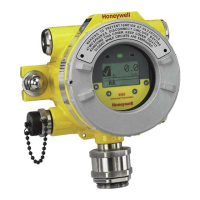141
Gas type Part Number Gas Type Applied Concentration Unit Reading Unit
PH
3
XNXXSP1SS
CarbonMonoxide 2000 ppm <10 ppmPH
3
Hydrogen 5000 ppm <10 ppmPH
3
Chlorine 1 ppm -70 ppmPH
3
NitrogenDioxide 8 ppm -860 ppmPH
3
Ethanol 2000 ppm <10 ppmPH
3
Iso-Propanol 1000 ppm <10 ppmPH
3
HydrogenChloride 10 ppm <10 ppmPH
3
HydrogenFluoride 10 ppm <10 ppmPH
3
HydrogenSulfide 0.5 ppm 70 ppmPH
3
Ammonia 100 ppm 1050(transient) ppmPH
3
SulfurDioxide 50 ppm 550(transient) ppmPH
3
Silane 1 ppm 364 ppmPH
3
Arsine 1 ppm 680 ppmPH
3
Diborane 1 ppm 454 ppmPH
3
Germane 1 ppm 454 ppmPH
3
Notes:
• Theguresofcross-sensitivityaretypicalvaluesandshouldnotbeusedasabasisforcrosscalibration�
• Cross-sensitivitiesmaynotbelinearandshouldnotbescaled�
• Forsomecross-interferentsbreakthroughmayoccurifgasisappliedalongertimeperiod�
• Therearemanygasesandvaporsthatcanpoisonelectochemicalcells�Itisdifculttogiveacompleteandexclusivelistofallspecies
whichwillhaveaneffectonthesensors�However,thesearesomecommonsubstanceswhichshouldbeavoided:
• Airbornegreases-Thesemayblockgasaccessintothesensorsandthereforereducesensitivity�
• Siliconecompounds-Theseareoftenfoundinsprays,aerosols,lubricants,polishes,adhesives,sealants,zebrastrip,cleaningagents,
andoorwaxes�Thesecompoundstendtoreducethesensitivityofthesensorsandgenerallywillhaveapermanenteffect�
• Solventsandorganicvapors-Manyorganicvaporswilldamagethesensors�SomecommononesareIPA,toluene,xylene,other
benzinederivatives,petrol,anddiesel�Itisdifculttogiveafulllistoforganicvapors,astherearesomanyofthem�Generally,any
organicvaporshouldbeavoided�
